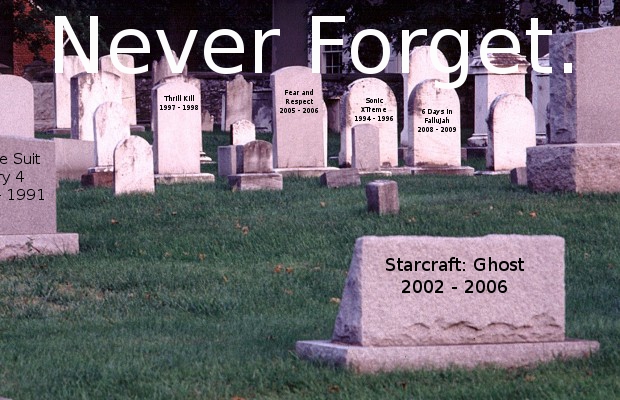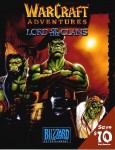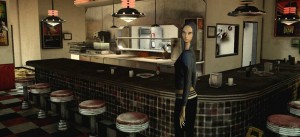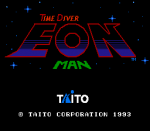Canceled Part 5: A Maximum Letdown Special
by William Talley, filed in Lost Classics, Maximum Letdown on May.29, 2014

This past memorial day, we remembered the brave men and women in our military who made the ultimate sacrifice for our freedom. We as gamers also remember the many games that have been left on the cutting room floor, some due to budget issues, others due to executive meddling, and others due to censorship. This list of titles once again mentions 10 games that didn’t make it past previews and concept stages. Some titles we were better off without. However, other titles were potential classics that were killed off before their time. All games mentioned deserved their time in the spotlight, even if metacritic would have given them a rating of only 5.5.
Warcraft Adventures: Lord of the Clans (PC)
 What it Was: A point-and-click adventure set in the Warcraft universe, centering around then-new character Thrall, the Orc clans, and what would be known in Warcraft lore as the Horde.
What it Was: A point-and-click adventure set in the Warcraft universe, centering around then-new character Thrall, the Orc clans, and what would be known in Warcraft lore as the Horde.What Happened: The game had been on track for a 1997 release, however it was delayed until the end of 1998. Although most of the areas, voice acting, and puzzles had been done, Blizzard wasn’t confident about the quality of their title. To that end, Blizzard hired Steve Meretzky (The Hitchhiker’s Guide to the Galaxy computer game) to assist with the rewrites. It was decided that the game’s refinements would requireheavy rewrites, and unfortunately that would mean that the game would not be able to make its 1998 deadline. Moreover, Lucasarts, at the time the leading name in the adventure gaming genre, had just released the hit Monkey Island III and its next hit, Grim Fandango would utilize a 3D graphics engine. Obviously, Warcraft Adventures would look dated in comparison, so a few days before E3 1998, the game was canceled. However, the game’s story was turned into a novelization, and would remain part of Warcraft canon as Thrall would be heavily featured in Warcraft III and World of Warcraft.
My Thoughts: Kudos to Blizzard for attempting to take one of its franchises outside the box, even if it didn’t work out. Sadly, this wouldn’t be the last time a Blizzard spin-off game would be canceled. Fortunately, the next time Blizzard tried something different with one of its franchises, it met with resounding success.
Command and Conquer Generals 2 (PC)
 What it Was:
What it Was: A sequel to 2003’s Command and Conquer Generals A free to play game based on Command and Conquer Generals. Players would take control of one of three factions as they battle in a single player Campaign online in free-to-play microtransaction based action against other players.
What Happened: To put it short, EA realized they weren’t giving players what they wanted. A few years ago, it was first announced that a new Command and Conquer game would be developed by Victory Games, a new studio formed by EA consisting of previous members of the EA Los Angles development team along with several new developers. The following year, it was announced that Command and Conquer Generals 2 was in development by Bioware Victory, a somewhat puzzling attempt to latch onto the popularity of Bioware’s Dragon Age and Mass Effect games (indeed, the game was promoted as being part of Bioware’s next big franchise). The next year, it was announced that not only would the game not have a single-player campaign, but it would be switched to a free-to-play model, and renamed simply Command and Conquer. Since 2012, news on the game was mostly quiet. However, at 2013’s E3, Ea announced that a beta of the game was going live that summer. However, the game would be canceled that October, as many players found fault with the game’s free-to-play multiplayer model.
My Thoughts: One has to question what EA was thinking. First of all, Generals was a highly underrated title among the Command and Conquer fandom, and we would have loved an all new game in the spinoff series, especially since C&C 4 failed to live up to expectations and the FPS spin-off Tiberium had been canceled. Also, the single-player campaigns have been a very important part of the franchise since the original C&C, and removing it from the new game would alienate a huge part of the audience. Now there is still hope for the franchise, as EA announced that the game is still in development under a different studio, and players who bought Command and Conquer: The Ultimate Collection would still receive a beta key.
The Crossing (Xbox 360, PC)
What it Was: A Source-engine powered first person shooter taking place across two parallel versions of modern-day Paris. In one, the government has collapsed and Paris has descended into anarchy. In the other, the Knights Templar took over the French Crown in 1307. The game’s aim was to mix single-player with multiplayer, as players who are playing Team Deathmatch take control of the game’s AI grunts as they either protect or attempt to kill the player who is making his or her way through the story.
What Happened: The developers ran into money problems and put the game ‘on hold’ in 2009. However, in 2012, it was revealed that developer Arkane Studios (Dishonored) had canceled the project to focus on Electronic Art’s LMNO, a game project featuring Steven Spielberg…that also ended up being canceled. Read All about it below!
My Thoughts: Too bad about this project, as the storyline seemed interesting and the single meets multiplayer also sounded intriguing as well, kinda like Demon’s Souls, except on a massive level. Hopefully the project can be picked up again, or a game with a similar concept will come across.
LMNO (PS3, PC, Xbox 360)

What it Was: Developed alongside Steven Spielberg, LMNO was a first person action-adventure with RPG elements. Playing as a character named Lincoln, you meet an alien-looking girl named Eve and the two of you must evade government agents. The game would make heavy use of parkour (similar to EA’s Mirror’s Edge), and Eve would evolve and gain special powers depending on how players treated her. In development since 2005, the goal was to create a game that would elicit emotions from players.
What Happened: Simply put, the game was too ambitious for its own good. In October 2008, EA laid off a majority of the LMNO team including Arkane studios, who had been bought in to assist with level design. Despite all features that the developers wanted to include in the game, all the team had to show for over two years of efforts was a prototype scene that took place in a 50’s style diner. Also, EA was leery about a product that didn’t have multiplayer and reportedly would only take 2 – 3 hours to finish (although the developers planned to include multiple endings for more replayability). At one point, the story, gameplay, and characters were radically changed to a third-person Uncharted ripoff where the alien Eve was replaced with a typically over-the-top attractive female. The game was killed off for good in 2009, just as EA was shifting it’s direction towards more online-focused gaming experiences.
My Thoughts: Sadly this wasn’t the first time that a big name Hollywood developer was involved with a video game project which would later end up canceled, nor was it the first dudfor Arkane Studios (although thankfully the company was scooped up by Bethesda and Zenimax studios a few years later, where they released the successful Dishonored). Seems like the developers at that particular branch of EA had the same problem that Peter Molyneux had: making big promises but being unable to deliver. Still, LMNO would have been the perfect vehicle for EA to give players a new gaming experience.
Castlevania Resurrection (Sega Dreamcast)
 What it Was: A Dreamcast installment of Konami’s flagship franchise, and what would have been the third Castlevania game for a Sega system (the first being Bloodlines on the Mega Drive/Genesis and the second being a Japan-only Saturn version of Symphony of the Night). The game would have seen Sonia Belmont (Last seen in the Game Boy Color Castlevania: Legends) teaming up with descendant Victor Belmont to battle a resurrected Dracula.
What it Was: A Dreamcast installment of Konami’s flagship franchise, and what would have been the third Castlevania game for a Sega system (the first being Bloodlines on the Mega Drive/Genesis and the second being a Japan-only Saturn version of Symphony of the Night). The game would have seen Sonia Belmont (Last seen in the Game Boy Color Castlevania: Legends) teaming up with descendant Victor Belmont to battle a resurrected Dracula.
What Happened: Shortly after the project was announced and screenshots were shown at E3 of 1999. Then the project was met with a series of delays. Finally, the project was put on “Indefinite Hold” in March of 2001. No concrete reason was given, but the project had been developed by Konami of America, which was said to have problems maintaining an adequate workforce. Seeing as how this was a late-era Dreamcast game however, it isn’t hard to imagine that the release of the PS2 had something to do with the cancellation. There was some hope that the project could have been revived on PS2, but Sonia Belmont was removed from the overall series canon with 2003’s Lament of Innocence and again with 2010’s Lords of Shadow.
My Thoughts: Yet another nail in the Dreamcast coffin. A Dreamcast-exclusive Castlevania would have been nice to have, but with its turbulent development, perhaps it was better for the project to be canceled.
Time Diver: Eon Man (NES)
 What it Was: An action platformer where players took control of a super hero who traveled through time to protect his family from a criminal organization out to do him like Sarah Connor.
What it Was: An action platformer where players took control of a super hero who traveled through time to protect his family from a criminal organization out to do him like Sarah Connor.
What Happened: No one knows. The game was completed, and it was even reviewed in Nintendo Power. A version of the game showed up in Asia from a company called Nitra, although it’s unknown if this was an official release or a bootleg. Of course this being a Nintendo game, a ROM is floating around the internet.
My Thoughts: Shame this title was canceled, even more so with no reason given. It wasn’t any worse than other games of that era with similar play styles, and it wasn’t like Taito was hurting for money.
Project H.A.M.M.E.R (Wii)
What it Was: A Nintendo-developed brawler in which players controlled a large armored fellow with a hammer. Players could attack enemies using wii-mote controlled motions.
What Happened: Who knows? Information about the title went dark after its 2006 E3 debut. As of 2014, there is no new info about the game.
My Thoughts: A shame. One of the biggest issues about the Wii (and its successor the Wii U) is the lack of games aimed at core audiences. A project like this would have been the prefect counter point to that argument. Not only would it have provided a solid traditional gaming experience for the Wii (or in this case Wii U), but it would also have been the beginning of a brand new franchise for Nintendo, two things the company desperately needs at this point.
Faith and A .45 (PS3, Xbox 360, PC)

What it Was: A cover-based shooter set in the 1920s. Starring a Bonnie and Clyde-esque couple, you (and a second player if playing either online or offline co-op) go on a string of bank robberies across the nation while staying one step ahead of the law and a ruthless oil baron. The game would have meshed Gears of War cover-heavy shooting action with heavy romance.
What Happened: Deadline Games (Total Overdose, Watchmen: The End is Nigh) had been struggling to find a publisher for the game, and the company closed up shop in 2009.
My Thoughts: Faith and a .45 seemed like the prefect union of fast paced shooter action and emotion one would get from a Shadow of the Colossus or an Ico. It was also shaping up to be the perfect game you could play with your gamer significant other.
Rendition: Guantanamo (PC, Xbox 360)
 What it Was: Developed by Scottish developer T-Enterprise, this game would have put players in the role of Adam, a fictional prisoner in the notorious Guantanamo Bay who must escape from the infamous prison camp which in the game is ran by mercenaries (so as to avoid having players kill American or British soldiers). The developers worked alongside controversial former prisoner Mozzam Begg, who was captured in Pakistan by the CIA after being suspected of aiding Al Qaeda. Begg provided consulting services and funding for the title.
What it Was: Developed by Scottish developer T-Enterprise, this game would have put players in the role of Adam, a fictional prisoner in the notorious Guantanamo Bay who must escape from the infamous prison camp which in the game is ran by mercenaries (so as to avoid having players kill American or British soldiers). The developers worked alongside controversial former prisoner Mozzam Begg, who was captured in Pakistan by the CIA after being suspected of aiding Al Qaeda. Begg provided consulting services and funding for the title.
What Happened: It’s not hard to guess what happened to this title given its subject matter. It was shelved due to overwhelming controversy as people believed that the game was either ‘Anti-American’ or ‘Pro-Al Qaeda’. Didn’t help matters that they couldn’t find a publisher either.
My Thoughts: As with 6 Days in Fallujah, this seems to be a case of uncomfortable and controversial subject matter way too soon. However, like SDIF, the public should have gotten the chance to play the game and judge for themselves to determine whether or not its content was appropriate for the consumer.
Hellraiser (NES)
 What it Was: A first person shooter (on the NES mind you) based on the horror movie franchise of the same name. The game would utilize a new form of “Super cartridge” which would allow it to pull off 16-bit color graphics, something that was unheard of on the 8-bit Nintendo. The cartridge itself contained a huge amount of Ram, and a separate Z-80 processor which would handle the bulk of the processing.
What it Was: A first person shooter (on the NES mind you) based on the horror movie franchise of the same name. The game would utilize a new form of “Super cartridge” which would allow it to pull off 16-bit color graphics, something that was unheard of on the 8-bit Nintendo. The cartridge itself contained a huge amount of Ram, and a separate Z-80 processor which would handle the bulk of the processing.
What Happened: Once again, we have a clear case of ambition exceeding capability, and this particular company had no right to have such ambition to begin with. Color Dreams (you’ve read about them once or twice on this site) was one of the leading makers of unlicensed NES products. They wanted to cash in on the movie to game adaptation craze of the 1990s. To that end, Color Dreams producer attempted to make games featuring everyone from Lee Majors (The 6 Million Dollar Man), Bela Lugosi, and even Zsa Zsa Gabor (she was rumored to be the subject of a game called cop slapper). When these plans fell through, founder Dan Lawton convinced the company to put up $50,000 to secure the license to Hellraiser. He then hired engineer Ron Risley to design the game’s cartridge. While the cartridge sounded impressive spec-wise, it became clear that it was gonna be painfully expensive to produce, so much so that the cart would have to cost over $100 in order for the company to break even. This would be difficult enough on it’s own, but Color Dreams produced unlicensed Nintendo products, meaning most video game stores wouldn’t carry them, and it’s violent content would no doubt end up being censored by Nintendo.
My Thoughts: While this no doubt would have been impressive, Color Dreams didn’t have the best track record when it came to overall quality, and lets face it, LICENSED movie adaptations on the NES weren’t exactly known for their stellar quality at the time. Besides, would a game based on Hellraiser really be a title appropriate enough to be released from a company called Color Dreams? Keep in mind that this was around the time the company began to publish Christian-oriented games under the name Wisdom Tree.
So everyone, bow your head and lets have a moment of silence for these 10 titles, along with the dozens of others that didn’t make it out the door either.


 PS3
PS3
 Famicom Dojo
Famicom Dojo KEEP PLAYING
KEEP PLAYING KEEP PLAYING: Rewind
KEEP PLAYING: Rewind Powet Toys
Powet Toys Powetcast
Powetcast Hitchhiker's Guide POWETcast
Hitchhiker's Guide POWETcast















Pingback: Canceled Vol 6: A Maximum Letdown Special - POWET.TV: Games, Comics, TV, Movies, and Toys